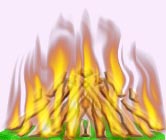|
Bhagatji
Maharaj's Birthday - The Swaminarayan Sampradaya also
celebrates the birth of Bhagwan Swaminarayan's second spiritual succesor
on this day.
This festival celebrates the arrival of spring on Fagun sud Purnima.
Also known as Falgunika, people celebrate the changing season
and the beauty associated with spring blossoms by spraying color.
In the Gita (10/35), Shri
Krishna proclaims spring as the foremost season and one of his Vibhutis
-forms:
Rutunaam kusumaakaraha
The ritual of offering
roasted grain to Agni - fire-deity is known as Navaanineshti.
In Sanskrit, roasted grain is Holaakaa, from which the Hindi 'Holi'
is derived. Since Vedic times people availed the newly harvested grain
only after offering to the devas. This offering of new grain is Holi.
The Bhavishyottara Puran
associates Holi both with man and yagna. Therefore the yagna performed
for man's salvation is Holi.
Holi's
Origin
There are several stories
associated with Holi.
-
The Bhavishyottara
Puran cites a story concerning a rakshasi (demoness)
named Dhundhaa, who harassed children and teenagers. To keep her
away, people kindled fires at various spots. Then the young and
later everyone else chanted God's name and circumambulated the fires.
Thus the Lord's name and fire kept the demoness away. In this manner,
Satya Yuga's king Raghu propagated the festival of Holi. Furthermore
it is believed that Dhundhaa manifests as disease in children, during
this period of seasonal change, when kapha (phlegm) increases
in the body. Fire is the shakti which protects one from disease.
Therefore wood of the Shami tree (Acacia suma) - symbolizing
Agni deity - is burnt in the fire to circumvent disease.
- Another belief concerns Putna, the giant
demoness who tried to kill the child Krishna. When he vanquished her,
the cowherds jubilantly burnt her body outside the village. Henceforth
the Holi festival came into being.
- More renowned is Prahlad's story. Hiranyakashipu,
a demon king and father of Prahlad, was a dissenter of Bhagwan Vishnu,
whom Prahlad worshipped. Infuriated by his son's devotion, Hiranyakashipu
attempted to kill him. In one attempt, he instructed his sister Holika,
to wear her miraculous sari, which could not burn, and then sit in
a fire with Prahlad in her lap. By the Lord's wish, she happened to
wear the wrong garment and was immolated. Symbolically, maya, in the
form of Holika, was destroyed by Prahlad's staunch devotion. Therefore
to eradicate our maya, we should offer unalloyed bhakti.
- This day also marks Lord Manu's birthday
anniversary. Mankind is Lord Manu's offspring. He composed the Manu
Smruti, a scripture regarded as a manual for man's life on earth.
- Nar-Narayan Deva's birthday anniversary
too, is celebrated on this day. As the fourth incarnation of Bhagwan
Vishnu, he is considered as the embodiment and incarnation of brahmacharya
(celibacy).
Import
Immersed in maya, pained and tainted by maya, man is exhorted to vanquish
his base instincts. The true Holi is in eradicating these instincts
and simultaneously being 'colored' by the Lord's 'color.'
Ritual
|



